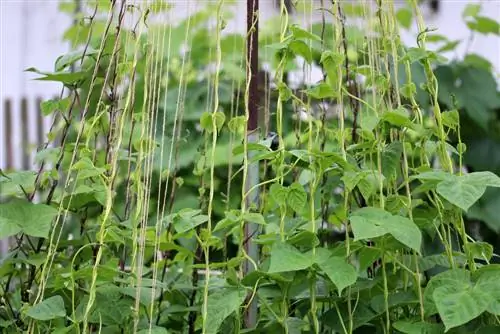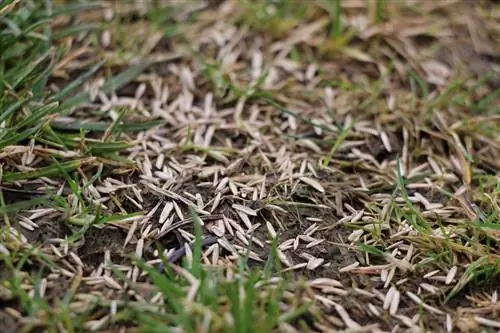- Author admin [email protected].
- Public 2023-12-17 03:39.
- Last modified 2025-06-01 06:48.
These herbs are not only delicious, but also he althy. Since they can be grown all year round, they are a reliable source of vitamins, especially in winter. While garden cress and nasturtiums are typically annuals, watercress can be both annual and perennial. Cress is very willing to grow and thrives on a wide variety of substrates. It can be grown indoors all year round and in the garden from spring to late summer.
Sowing
Cress is usually grown by sowing. Traditional perlite substrate can be used as well as hemp and flat fibers or a growing fleece. Even simple paper tissues and cotton wool are suitable for cultivation. The seeds can be purchased commercially or harvested from existing plants by leaving them until they bloom. If the flowers have dried up, you can pick the seeds and use them for the next sowing or store them in small bags.
Sowing outdoors
Cress can be sown in rows or over a wide area. The best time to sow seeds in the garden is from mid-May to September. The soil should have a temperature of at least 15 degrees so that the seeds can germinate, as the plants are very sensitive to frost. Before sowing, the soil in the planting area should be thoroughly loosened. Then you plant appropriate rows of seeds about 15 cm apart.
Cress seeds are light germinators, i.e. i.e. they need light to germinate. As a result, they are only lightly pressed onto the ground and not covered with soil. The purpose of pressing is to prevent the seeds from being washed away during heavy rainfall. In contrast to garden cress, watercress requires a little more space and should therefore be spread thinner. It is also advisable to mix watercress seeds with a little fine sand as they are very tiny.
Once the seeds have been distributed, care should be taken to ensure that the soil is permanently and evenly moist. Separating or pricking out can be completely avoided, especially with these plants. Transplanting is also not worth it as they are only cultivated for a very short time. Depending on the type of cress, it can be harvested after just 1 - 4 weeks. Of course, the prevailing temperatures play a crucial role. At best they should be between 18 and 23 degrees.
Tip:
Thanks to the relatively short growing season, cress sown in early autumn can be harvested before the first frosts. Accordingly, subsequent sowings can be done until autumn.
Sowing on the windowsill
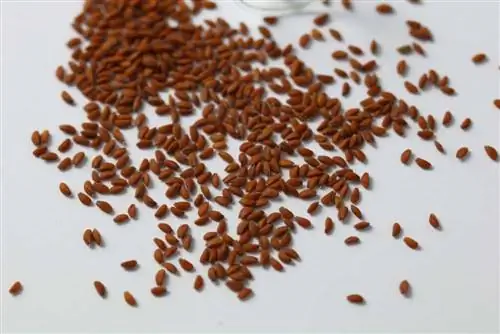
Sowing on the windowsill is also child's play and possible all year round. You can sow in a classic substrate such as slightly sandy herb soil, but also in cotton wool, kitchen paper or paper handkerchiefs. Cress thrives almost everywhere. There are hardly any limits when it comes to choosing planters. Actually, everything that a normal household has comes into question, from bowls, plates and glasses to pots to classic egg cartons and other more or less decorative vessels. No matter what you ultimately decide on, the planter should always be clean, ideally even germ-free.
- First fill the planter with the desired substrate
- Soak the substrate or base with water
- Pour off excess water afterwards
- Otherwise there is a risk of mold formation
- Then distribute the seeds as evenly as possible on the substrate
- Again, do not cover the seeds
- Keep the seeds consistently moist until germination
- Waterlogging must be avoided at all costs
- It is best to use a conventional spray bottle to moisten the substrate
- This applies especially to cultivation in bowls, pots or similar
- The fine spray mist moistens the substrate without washing away the seeds
- With a watering can the water jet would be too strong
- Finally put the whole thing in a bright place
- A good place is the windowsill, here the seeds get enough light
Tip:
If you want to harvest fresh cress continuously for seasoning or to enjoy on its own, you can sow again every few days. However, you should never sow too much cress at once, as it only lasts for a very limited time unless it is to be frozen.
Sow new seeds every year
In contrast to most other herbs, which can be harvested continuously and sprout again and again, cress does not grow back and has to be sown again every year. This is due to the so-called growth point, the center of growth, where the cells divide particularly strongly. While with other herbs, flowers and grasses it is usually close to the ground, with cress it is under the leaves and is removed when harvesting. As a result, the plants cannot grow any further.
Mixed culture beneficial
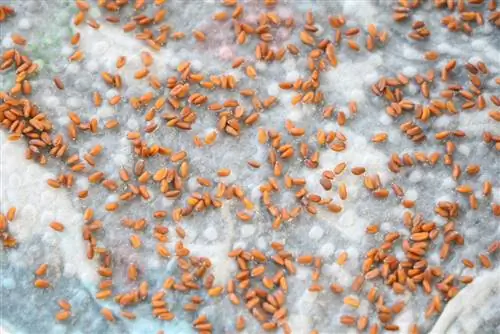
A mixed culture has several advantages. The right plant combinations can protect against pest infestation and diseases, support germination or improve the taste oremphasize or enhance the aroma of plants and fruits. But they can also harm each other.
As a result, cress should, if possible, not be planted or sown in locations where cruciferous vegetables such as radishes, radishes or cabbage have already grown. The situation is different if, for example, you plant nasturtiums or garden cress next to potatoes, runner beans, tomatoes or fruit trees, where they can keep aphids away. If you plant cress next to carrots or radishes, it can protect both types of vegetables from damage caused by flea beetles. By the way, garden cress gets along well with all leaf salads.
Care instructions
Cress was used as a seasoning and medicinal plant in ancient times and was grown in many monastery gardens. Thanks to its undemanding nature, it can be grown almost anywhere, regardless of the season. If it gets too cold outside, just move the whole thing indoors. The care is almost exclusively limited to the right amount when watering.
Site conditions
Cress can be grown almost anywhere in the garden. Locations in a sunny location are ideal; this is where it thrives particularly well. But sowing is also possible in shady places, although here it takes a little longer until harvest. The soil or base should be moist and have good water storage capacity, both in the garden and on the windowsill. Otherwise, cress thrives on any normal garden soil, even on very poor and depleted soils.
Watering and fertilizing
- Watering is the most important part of care
- Substrate must be kept consistently moist
- This applies from the time of sowing and throughout the entire culture
- The substrate of choice should neither be waterlogged nor completely dry out
- Both of these can be easily avoided by moistening with a spray bottle
- A strong jet of water from the watering can would cause too much moisture
- It would also wash away the fine seeds
- Always allow excess water to drain off after watering
Tip:
Fertilizer can be completely dispensed with when growing cress, even if the soil is completely exhausted, because these small plants draw all their strength from the seeds.
Propagation
In order to be able to sow again and again, you can harvest seeds from existing plants. To do this, some of the plants are left until they bloom. After they have finally flowered, the seeds can be harvested and dried. However, plants that are grown on the windowsill are difficult to get to bloom.
Basically, to obtain seeds you should only use plants that were sown in spring or at most in early summer, as this is where the chance of them blooming is greatest. The dried seeds can then be placed in small paper bags and stored in a dry and dark place until sowing.
Cress seeds remain germinable for up to four years. Most types of cress are only suitable for short-term cultivation. Nevertheless, watercress, for example, is a perennial species and there are also perennial varieties of nasturtium that can easily be propagated from cuttings.
Propagation of cuttings
Watercress
Watercress is a perennial type of cress, which is why it can be worthwhile to propagate it via cuttings. To do this, break off a corresponding number of root branches and put about half of them into a waterproof planter in a sand-compost mixture. Since this type of cress is a marsh or aquatic plant, the substrate mixture should always be covered with water, which also promotes rapid root formation.
Nasturtium
- Propagation from cuttings is also possible for perennial varieties of nasturtium
- You cut off shoot tips about 15 cm long
- These are placed in small pots with moist growing substrate
- Then put the whole thing in a warm place
- Temperatures between 20 and 25 degrees are optimal
- From now on, keep the substrate evenly moist
- Cuttings usually root within a week
- Then they can be planted out in the garden on the spot
Diseases
Rotting/mould formation
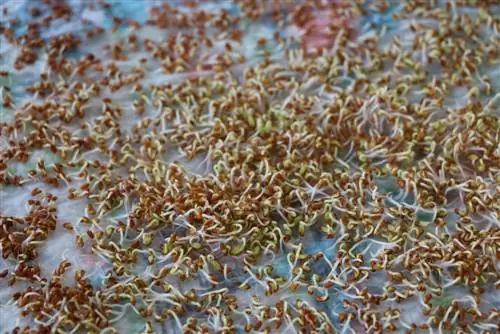
The greatest enemy of cress is too much moisture, especially when cultivated indoors. Rot and mold formation can be avoided by always pouring off excess water immediately, for example when sowing on cotton wool, kitchen paper or similar. If the infestation is severe, you should dispose of the plants and grow them again. To prevent mold formation, cress can also be grown in two containers or bowls one above the other. The top one into which the seeds are sown is equipped with drainage holes so that excess water can drain into the lower bowl and be removed. Rotting cress is hardly a problem in the garden.
Downy mildew
Downy mildew is particularly an issue with watercress if it is in standing water, because downy mildew loves moisture. Infected plants should be removed. They are no longer suitable for consumption. It is best to remove the plants completely and sow again. When growing in planters, after removing the plants, they should be thoroughly cleaned and, if necessary, disinfected before being replanted.
Pests
Aphids
Aphids can appear on nasturtiums and watercress, which is why these types of cress are often planted as aphid catchers. They are usually black lice that sit on shoots and leaves. To combat them, you can spray infected plants with a mixture of 1 liter of water, 15 ml of soft soap and 1 tablespoon of spirit until the infestation is eliminated.
Snails
Snails are particularly attracted to watercress, especially slugs. To get rid of them, you should pick the animals again and again, preferably in the morning. Of course, you can also use commercially available slug pellets to combat the pests, but then the plants are no longer suitable for consumption.
Harvest
Garden cress (Lepidium sativum)
Garden cress can be harvested after about two weeks. It is best to harvest in the morning, when the leaves are particularly rich in essential oils. The delicate plants are cut off just above the ground. Both the leaves and the flowers can be eaten as long as they are allowed to bloom. However, the plants lose their aroma as they bloom. That's why garden cress is usually harvested right before flowering. It can be eaten raw but can also be used to make cress oil, cress butter or pesto.
Watercress (Nasturtium officinale)
Watercress is also usually harvested before flowering, from September onwards. In contrast to garden cress, watercress always grows back, so that there are always shoots ready for harvest throughout the summer. If possible, you should always prune the entire plant. Once the tender shoots have reached a length of approx. 5 - 7 cm, they should taste particularly aromatic, be it traditionally on sandwiches, as an addition to salads or prepared as a vegetable. The flowers can also be used as a salad addition, to decorate salads and other dishes or to make herb butter.
Nasturtium (Tropaeolum)
The young leaves of the nasturtium are harvested before they bloom. However, the colorful and edible flowers are much more popular. New flowers can be harvested again and again from the end of June until the first frost. Leaves and flowers can be used in salads, herbal vinegar or flower oil. In addition, the buds can be pickled in vinegar and used as a substitute for capers. The dried seeds of nasturtium can also be used, for example to prepare teas, season dishes or pickled in vinegar.
Storage
Basically, cress, regardless of the variety, should always be used quickly because it usually only stays fresh for a very short time. It is not suitable for drying. If you want to use them to season dishes, you can chop them up and freeze them in ice cube trays. Due to their limited shelf life, you should only harvest as much as you can use or process in the shortest possible time.
Conclusion
Cress is one of the herbs that should not be missing in any kitchen. If you sow again and again, you can get fresh cress all year round. Growing it is child's play because it germinates on almost any absorbent surface and the waiting time from sowing to harvesting is very short. With its slightly spicy note, it can season dishes or be used as decoration. In addition, it is a source of vitamins, potassium, iron and folic acid that should not be underestimated.




